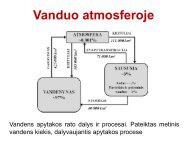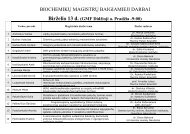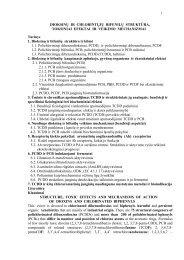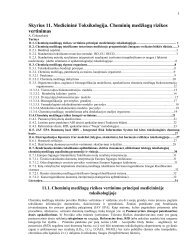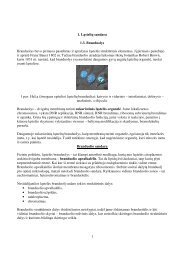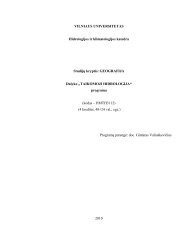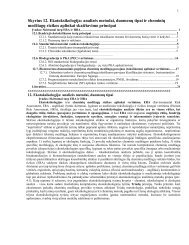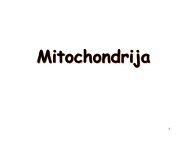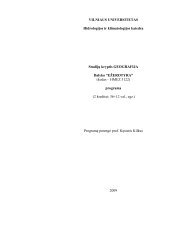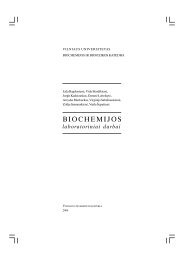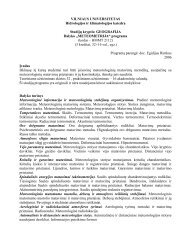486 CHAPTER TWENTY-FOURlations <strong>of</strong> wind-pollinated plants are isolated at the maximumdistance pollen can be blown by the wind, but individualplants are effectively isolated at much shorter distances.Among animal-pollinated plants, the width <strong>of</strong> the barrier isthe distance that animals can travel while carrying pollen orseeds. Even animals with great powers <strong>of</strong> dispersal are <strong>of</strong>tenreluctant to cross narrow strips <strong>of</strong> unsuitable habitat. For animalsthat cannot swim or fly, narrow water-filled gaps maybe effective barriers. However, gene flow can sometimes beinterrupted even in the absence <strong>of</strong> physical barriers.MeiosisHaploid gametes(one copy <strong>of</strong> eachchromosome)Sympatric speciation occurs without physical barriersAlthough physical isolation is usually required for speciation,under some circumstances speciation can occur withoutit. Such a partition <strong>of</strong> a gene pool is called sympatric speciation(sym-, “with”). The most common means <strong>of</strong> sympatricspeciation is polyploidy, the production within an individual<strong>of</strong> duplicate sets <strong>of</strong> chromosomes. Polyploidy can ariseeither from chromosome duplication in a single species(autopolyploidy) or from the combining <strong>of</strong> the chromosomes<strong>of</strong> two different species (allopolyploidy).An autopolyploid individual originates when (for example)cells that are normally diploid (with two sets <strong>of</strong> chromosomes)accidentally duplicate their chromosomes, resultingin a tetraploid (four sets <strong>of</strong> chromosomes) individual.Tetraploid <strong>and</strong> diploid plants <strong>of</strong> the same species are reproductivelyisolated because their triploid <strong>of</strong>fspring are essentiallysterile.Even if triploid individuals survive to reproductive maturity,they cannot produce viable gametes because theirchromosomes do not synapse correctly during meiosis (Figure24.7). So a tetraploid plant cannot produce viable <strong>of</strong>f-The diploidparent has twocopies <strong>of</strong> eachchromosomeMatingMeiosisMost gametes producedby the triploid hybridare not viable becausethey have an incorrectnumber <strong>of</strong> chromosomes.The F 1 <strong>of</strong>fspring istriploid (three copies<strong>of</strong> each chromosome)MeiosisDiploid gametes(two copies <strong>of</strong>each chromosome)The tetraploidparent has fourcopies <strong>of</strong> eachchromosome.24.7 Tetraploids Are Soon Reproductively Isolated from DiploidsEven if the triploid <strong>of</strong>fspring <strong>of</strong> diploid <strong>and</strong> tetraploid parents reachessexual maturity, most <strong>of</strong> the gametes it produces have inviable numbers<strong>of</strong> chromosomes. Such triploid individuals are effectively sterile.(For simplicity, the diagram shows only three chromosomes; mostspecies have many more than that.)
SPECIES AND THEIR FORMATION 487spring by mating with a diploid individual—but it can do soif it self-fertilizes or mates with another tetraploid.Allopolyploids may be produced when individuals <strong>of</strong> twodifferent (but closely related) species interbreed, or hybridize.Allopolyploids are usually fertile because each <strong>of</strong> thechromosomes has a nearly identical partner with which topair during meiosis.New species arise by means <strong>of</strong> polyploidy much more easilyamong plants than among animals because plants <strong>of</strong>many species can reproduce by self-fertilization. In addition,if polyploidy arises in several <strong>of</strong>fspring <strong>of</strong> a single parent, thesiblings can fertilize one another. Speciation by polyploidyhas been very important in the evolution <strong>of</strong> flowering plants.Botanists estimate that about 70 percent <strong>of</strong> flowering plantspecies <strong>and</strong> 95 percent <strong>of</strong> fern species are polyploids. Most <strong>of</strong>these arose as a result <strong>of</strong> hybridization between two species,followed by self-fertilization.How easily allopolyploidy can produce new species is illustratedby the salsifies (Tragopogon), members <strong>of</strong> the sunflowerfamily. Salsifies are weedy plants that thrive in disturbedareas around towns. People have inadvertentlyspread them around the world from their ancestral ranges inEurasia. Three diploid species <strong>of</strong> salsify were introduced intoNorth America early in the twentieth century: T. porrifolius,T. pratensis, <strong>and</strong> T. dubius. Two tetraploid hybrids—T. mirus<strong>and</strong> T. miscellus—between the original three diploid specieswere first discovered in 1950. The hybrids have spread sincetheir discovery <strong>and</strong> today are more widespread than theirdiploid parents (Figure 24.8).Studies <strong>of</strong> their genetic material have shown that both salsifyhybrids have formed more than once. Some populations<strong>of</strong> T. miscellus—a hybrid <strong>of</strong> T. pratensis <strong>and</strong> T. dubius— havethe chloroplast genome <strong>of</strong> T. pratensis; other populations havethe chloroplast genome <strong>of</strong> T. dubius. Such differences amonglocal populations <strong>of</strong> T. miscellus show that this allopolyploidhas formed independently at least 21 times! Scientists seldomknow the dates <strong>and</strong> locations <strong>of</strong> species formation so well. T.mirus, a hybrid <strong>of</strong> T. porrifolius <strong>and</strong> T. dubius, has formed 12times. T. porrifolius prefers wet, shady places; T. dubius prefersdry, sunny places. T. mirus, however, can grow in partlyshaded environments where neither parent does well. Thesuccess <strong>of</strong> these newly formed hybrid species <strong>of</strong> salsifies illustrateswhy so many species <strong>of</strong> flowering plants originatedas polyploids.Polyploidy, as we have just seen, can result in a newspecies that is completely reproductively isolated from its parentspecies in one generation. Allopatric speciation proceedsmuch more slowly, <strong>and</strong> some populations separated by aphysical barrier may never acquire full reproductive isolation.Let’s see how reproductive isolation may become establishedonce two populations have been separated from each other.A tetraploid hybrid has an almostcontinuous range in an areaaround Spokane, Washington.The range <strong>of</strong>tetraploid hybrids ( )is broader than that <strong>of</strong>diploid parentalspecies ( ).24.8 Polyploids May Outperform <strong>Their</strong> Parent <strong>Species</strong>Tragopogon species (salsifies) are members <strong>of</strong> the sunflower family.The map shows the distribution <strong>of</strong> the three diploid parent species<strong>and</strong> <strong>of</strong> the two tetraploid hybrid species <strong>of</strong> Tragopogon in easternWashington <strong>and</strong> adjacent Idaho.Completing Speciation:Reproductive Isolating MechanismsOnce a barrier to gene flow is established, by whatevermeans, the separated populations may diverge geneticallythrough the action <strong>of</strong> the evolutionary agents we describedin Chapter 23. Over many generations, differences may accumulatethat reduce the probability that members <strong>of</strong> the twopopulations could mate <strong>and</strong> produce viable <strong>of</strong>fspring. In thisway, reproductive isolation can evolve as an incidental byproduct<strong>of</strong> genetic changes in allopatric populations.Geographic isolation does not necessarily lead to reproductiveincompatibility. For example, American sycamores<strong>and</strong> European sycamores (also known as plane trees) havebeen physically isolated from one another for at least 20million years. Nevertheless, they are morphologically verysimilar (Figure 24.9), <strong>and</strong> they can form fertile hybrids,even though they never have an opportunity to do so innature.In other cases, however, genes that result in reproductiveisolation between two evolving lineages spreadquickly through populations as they diverge. In this section,we will examine the ways in which reproductive isolatingmechanisms may arise. In the following section, wewill explore what happens when reproductive isolation isincomplete.



